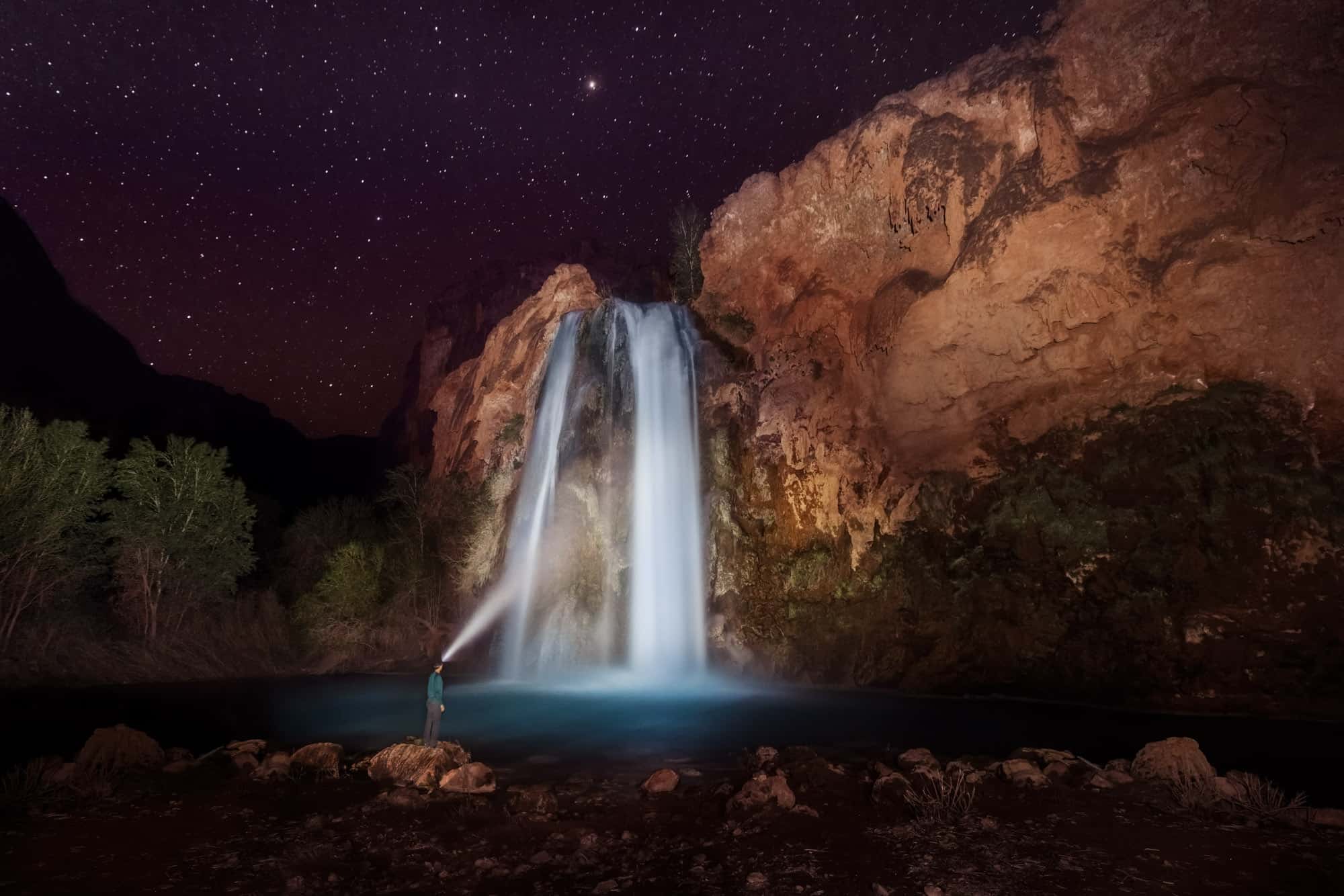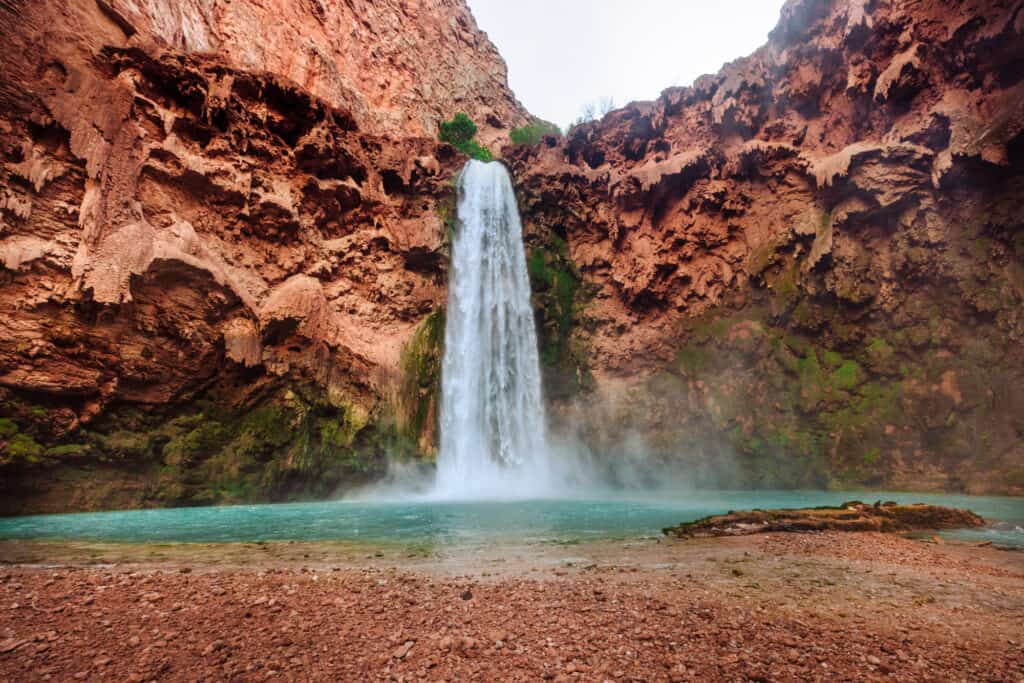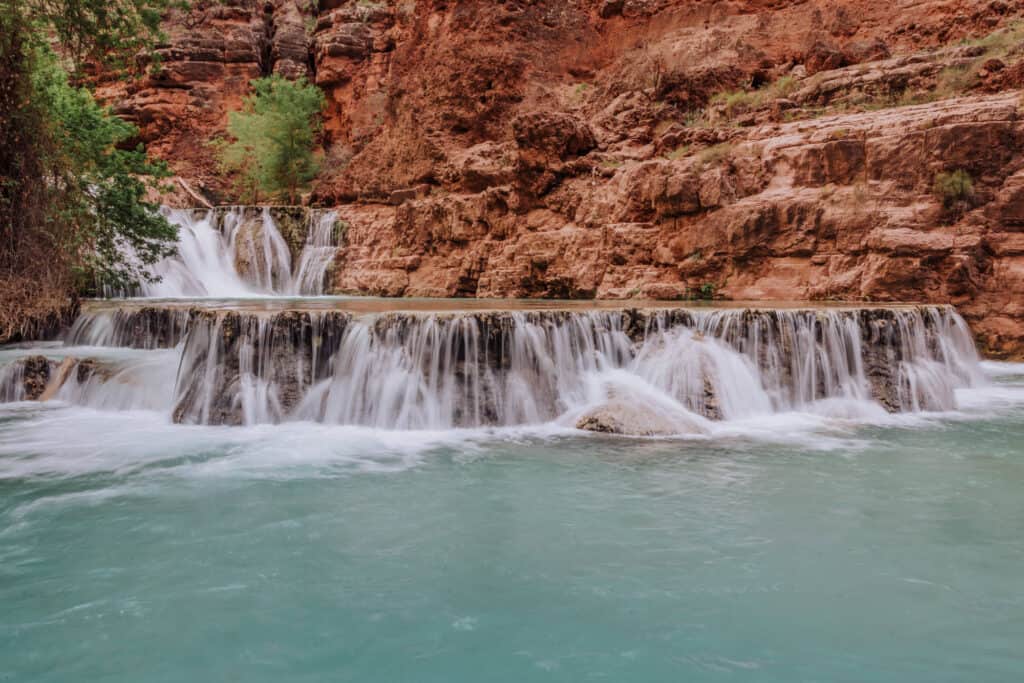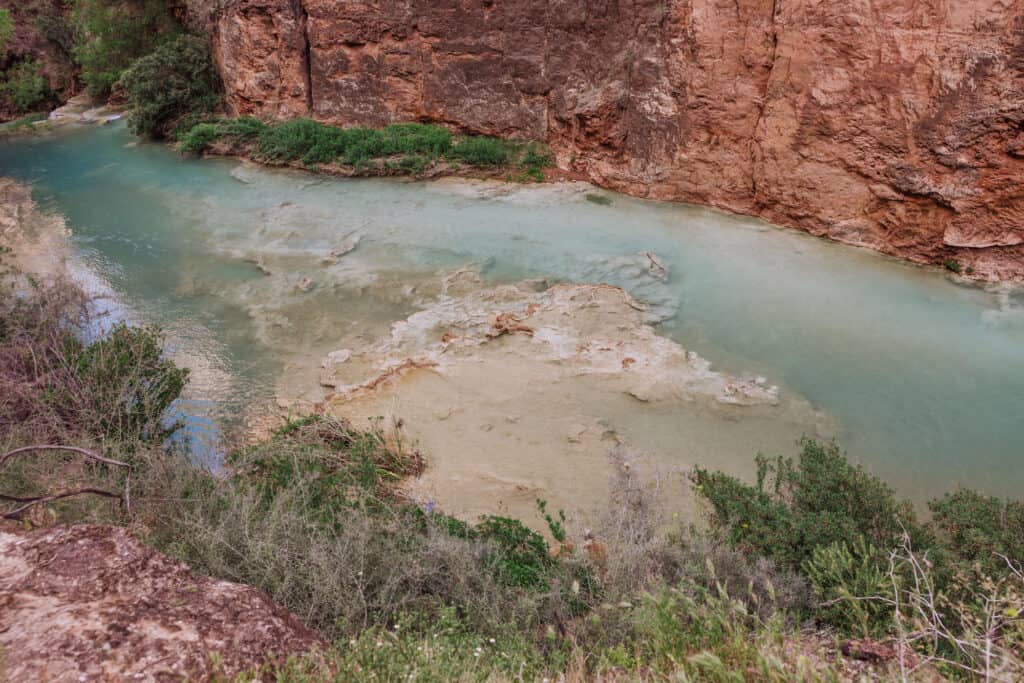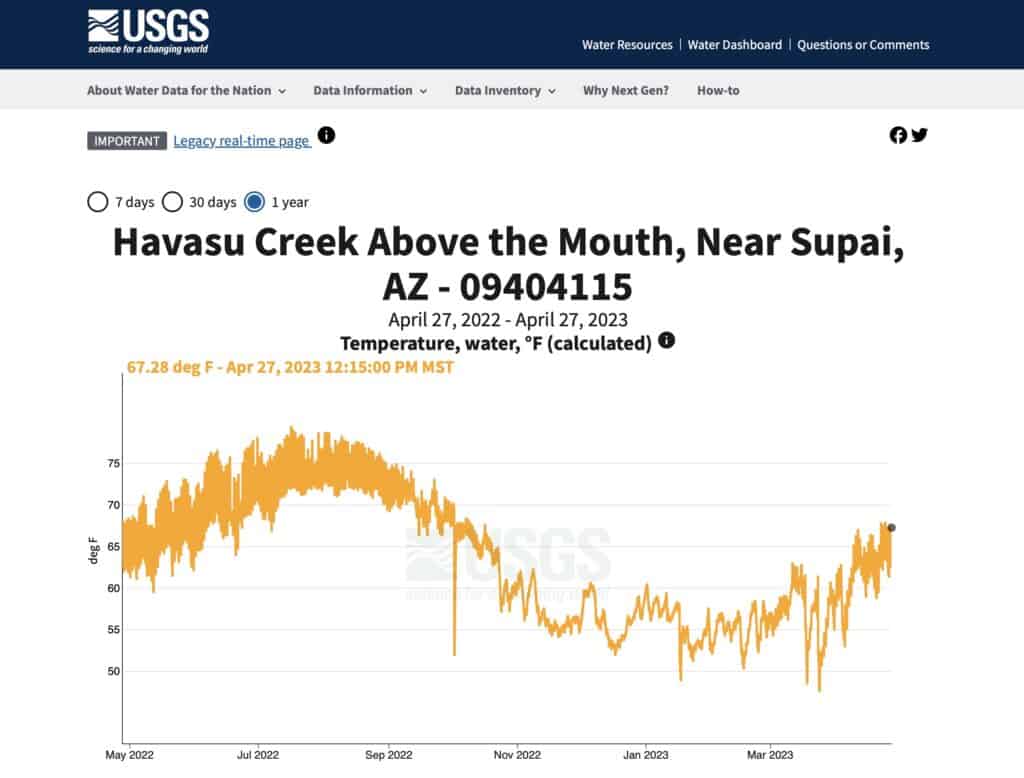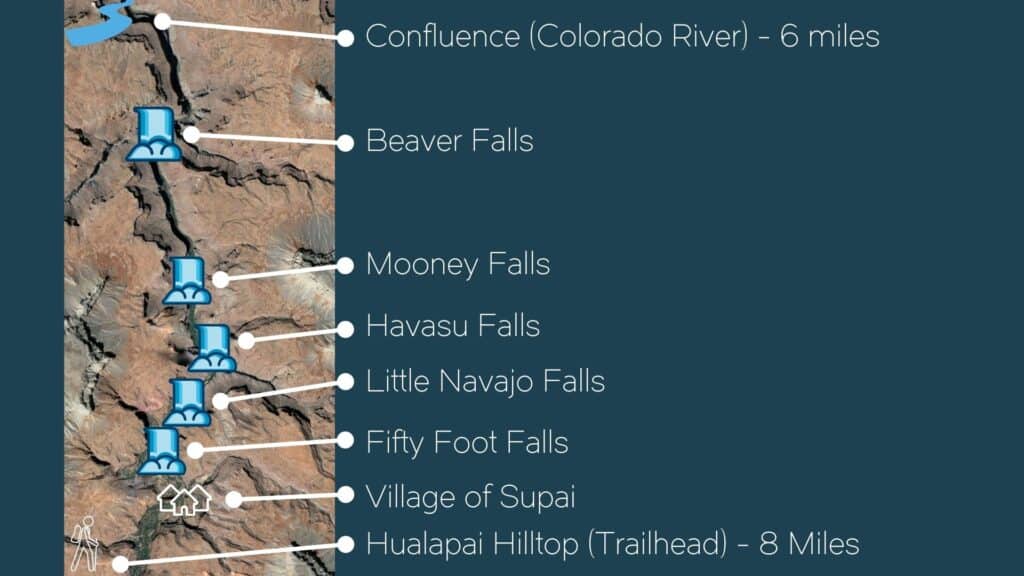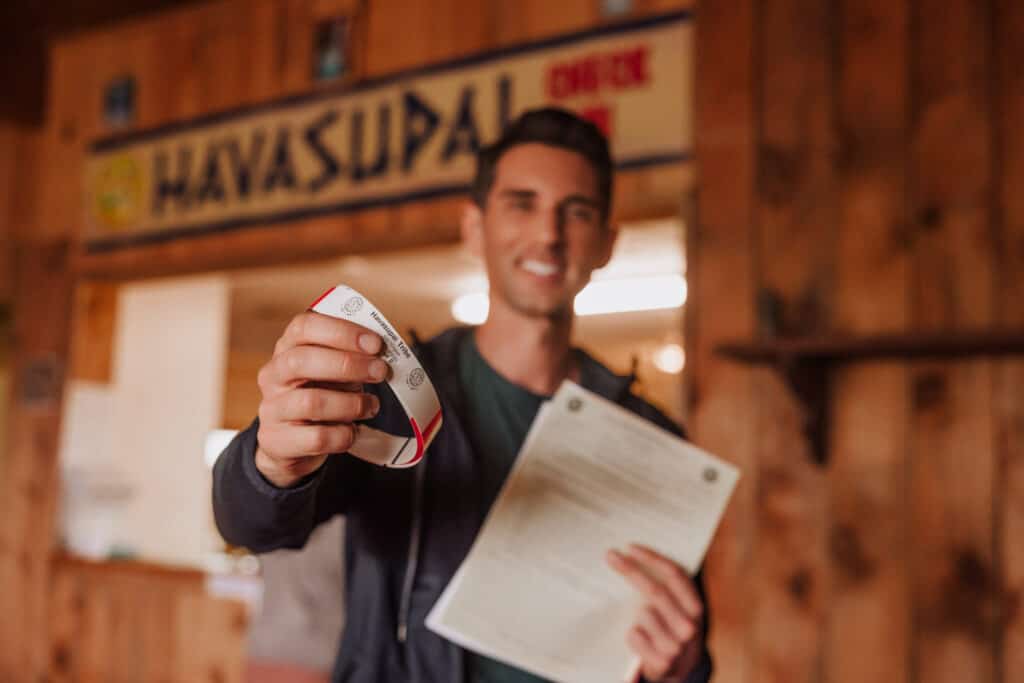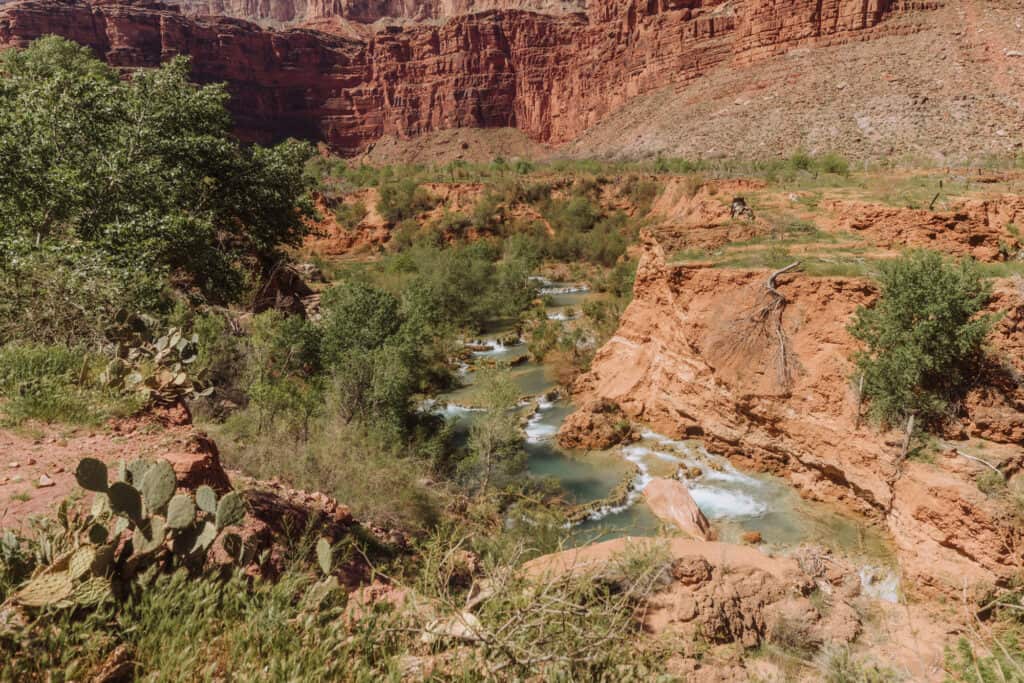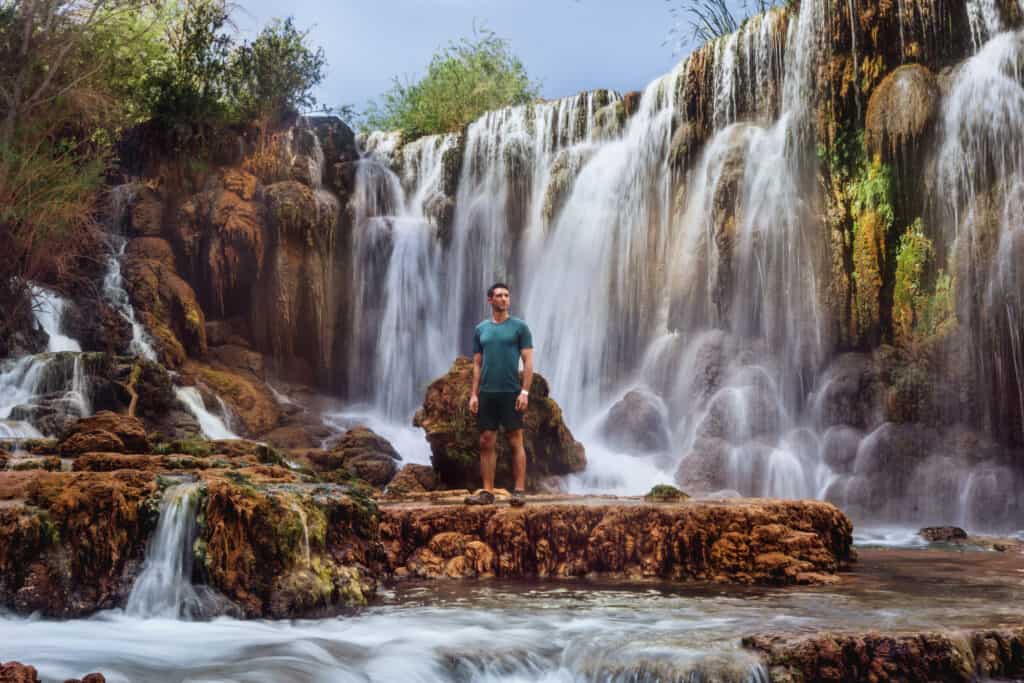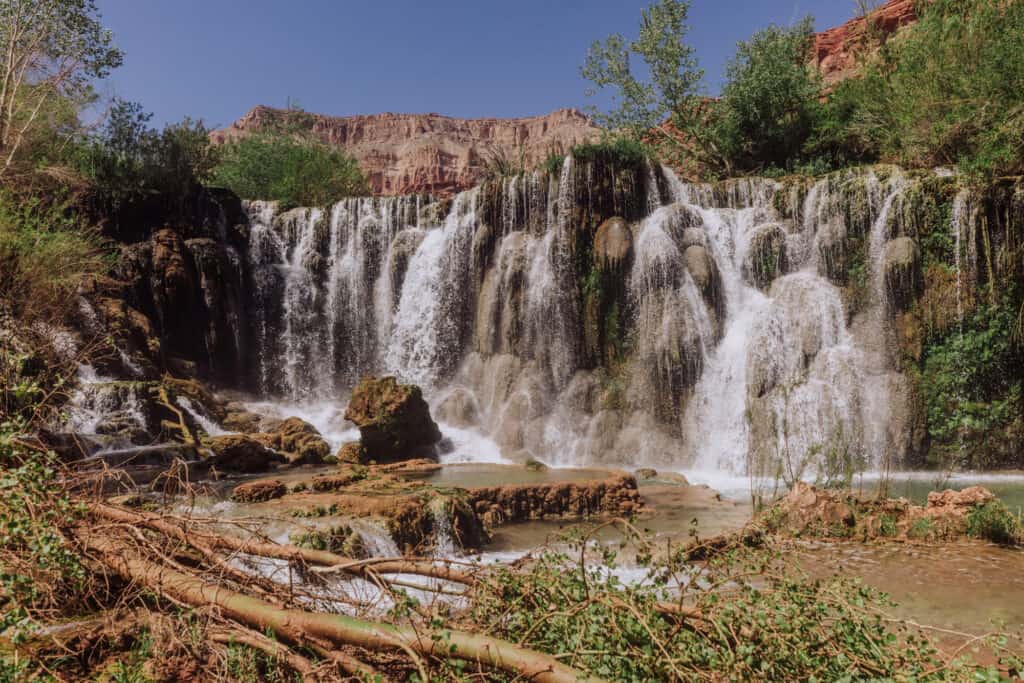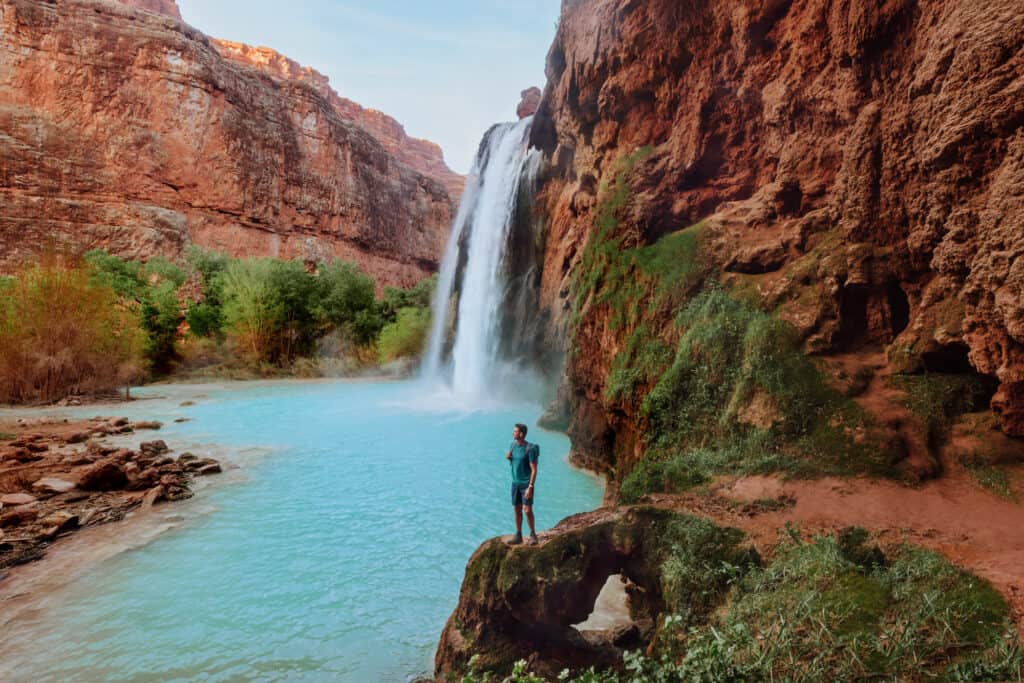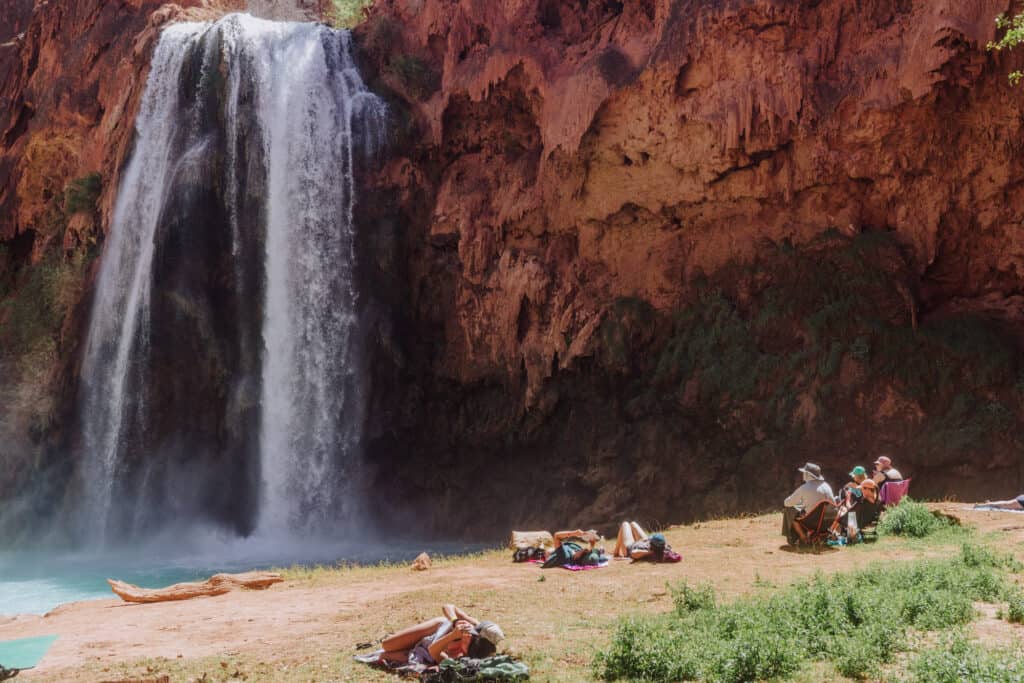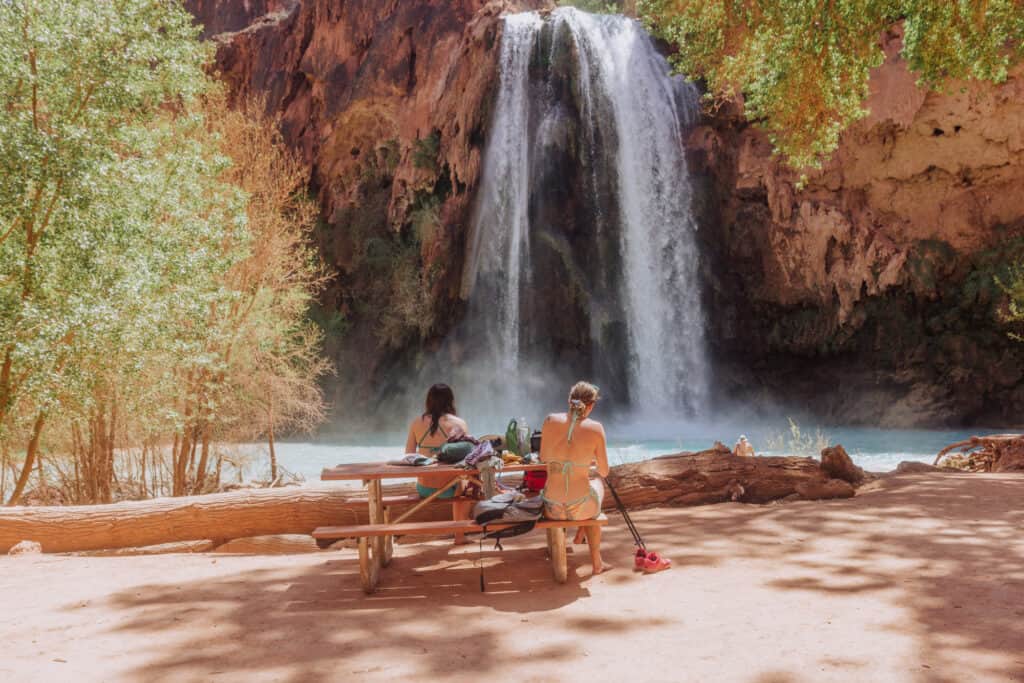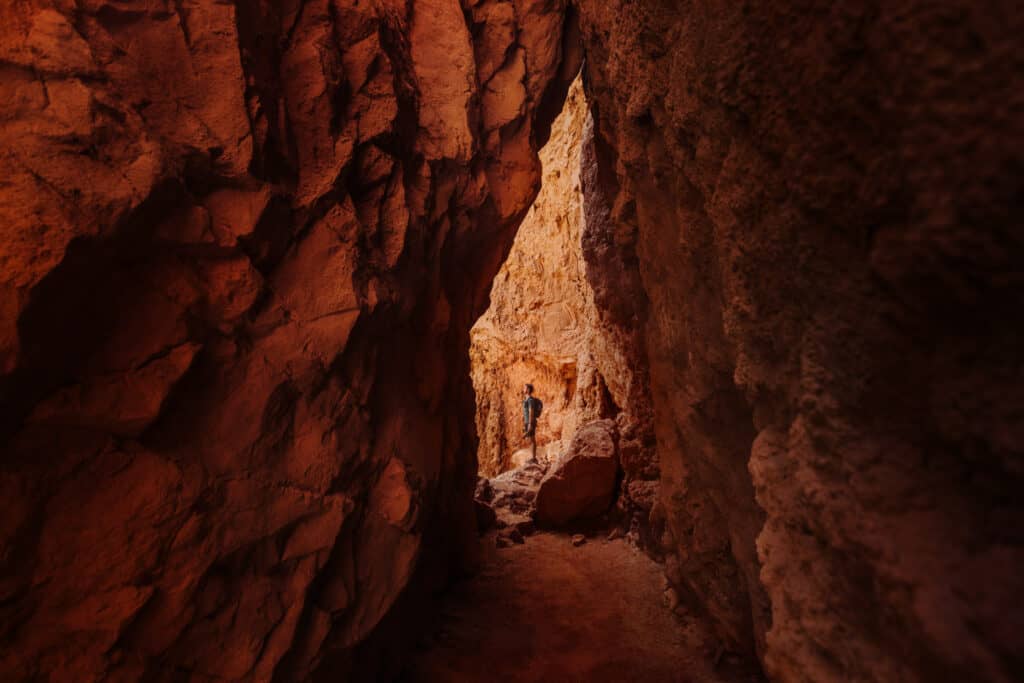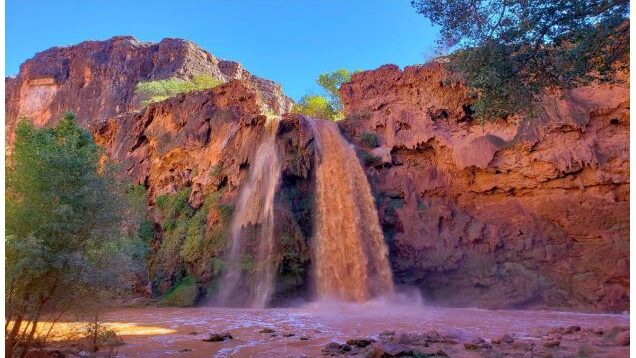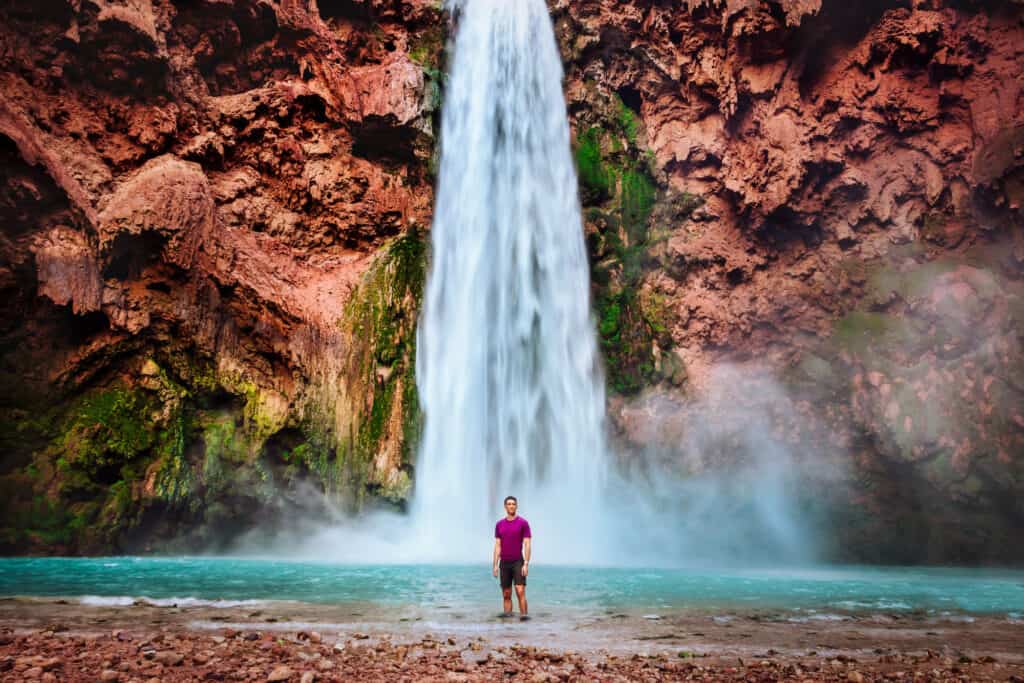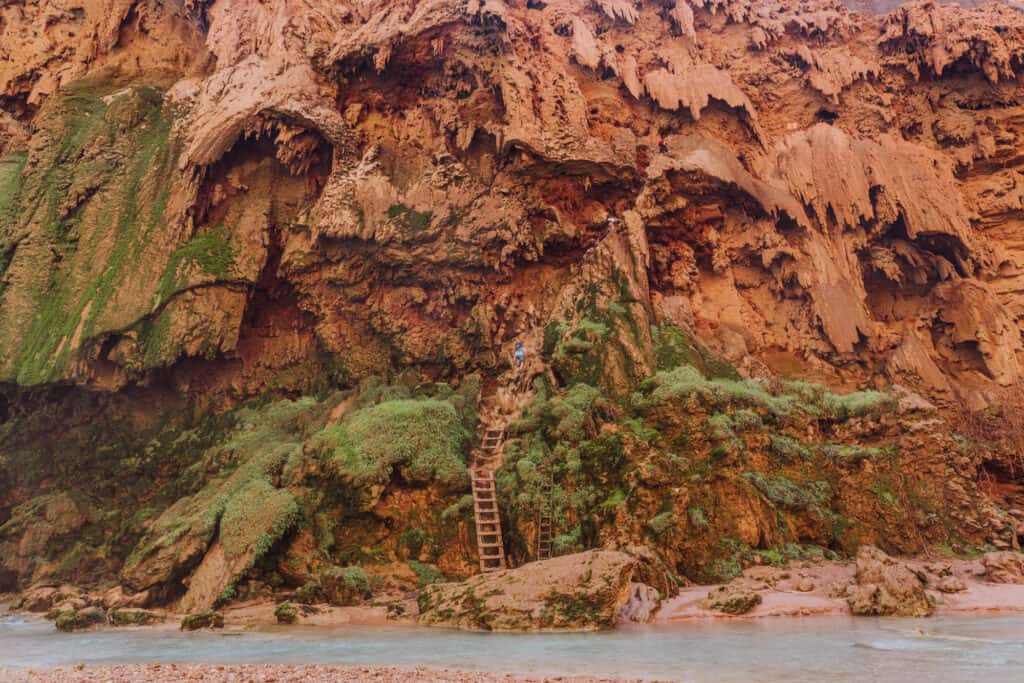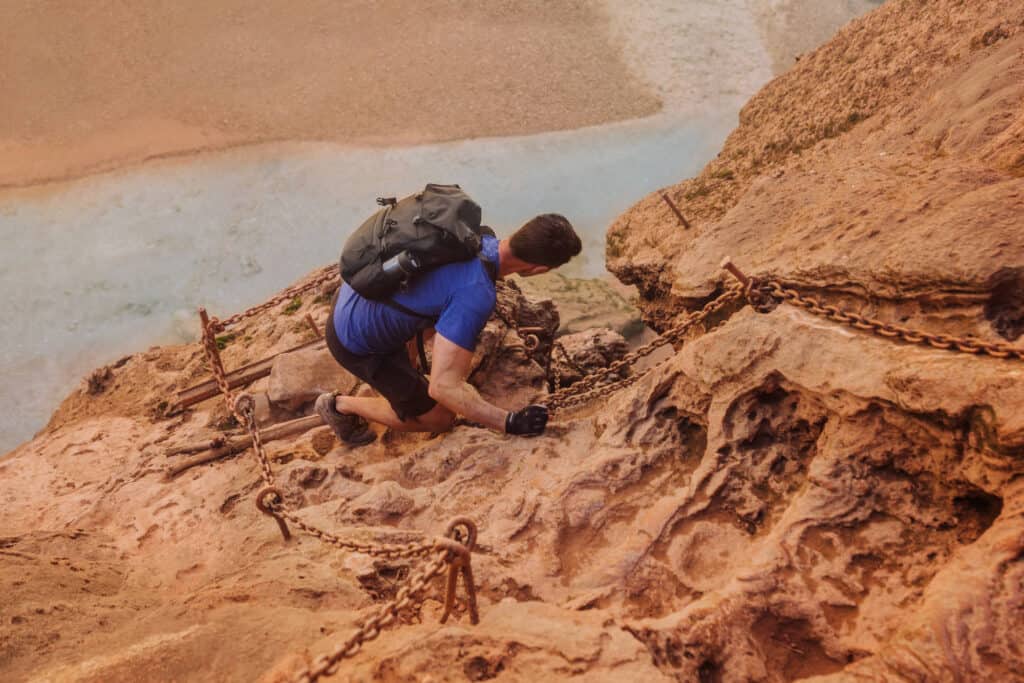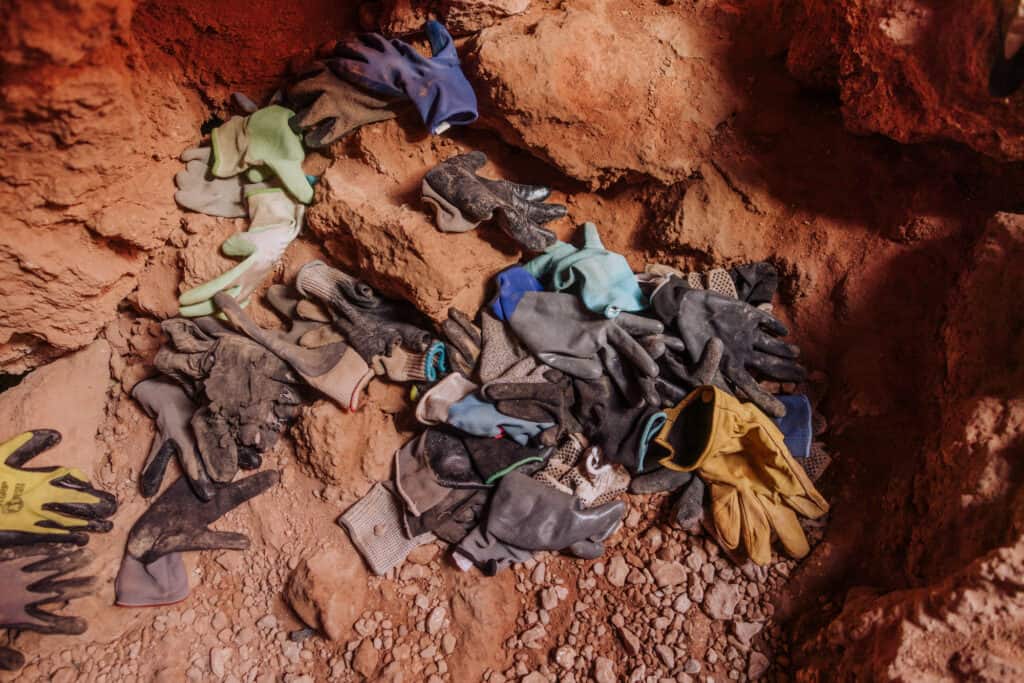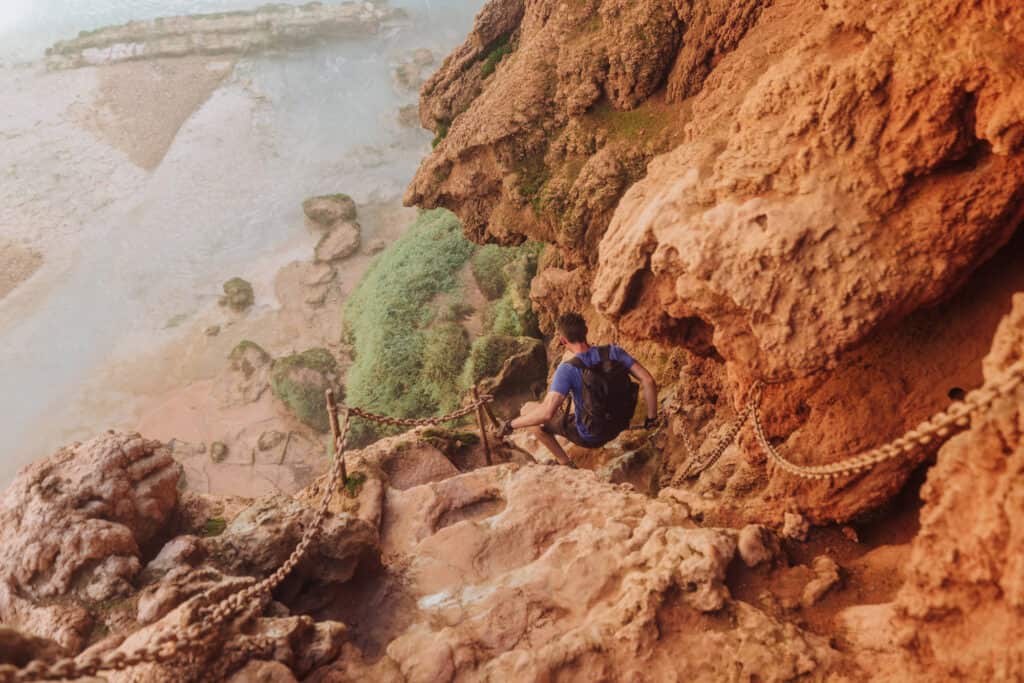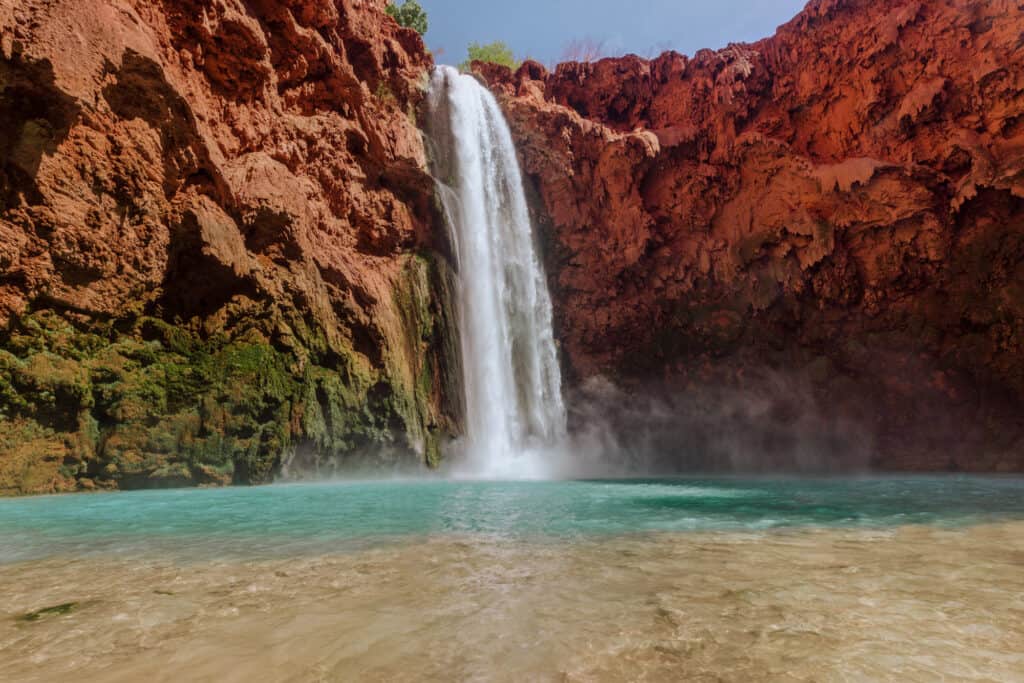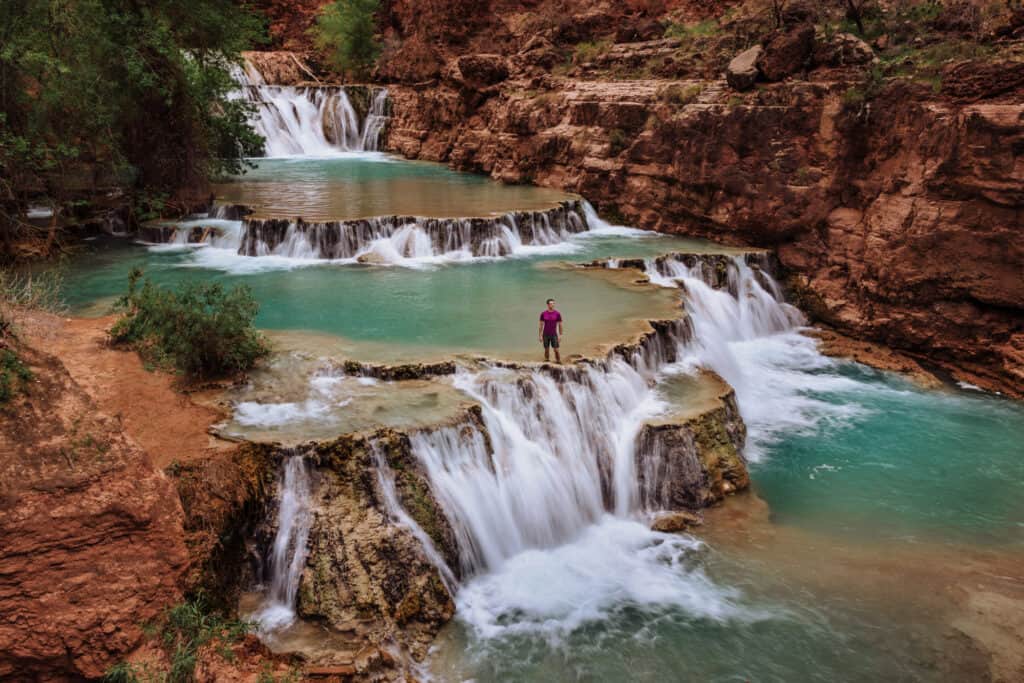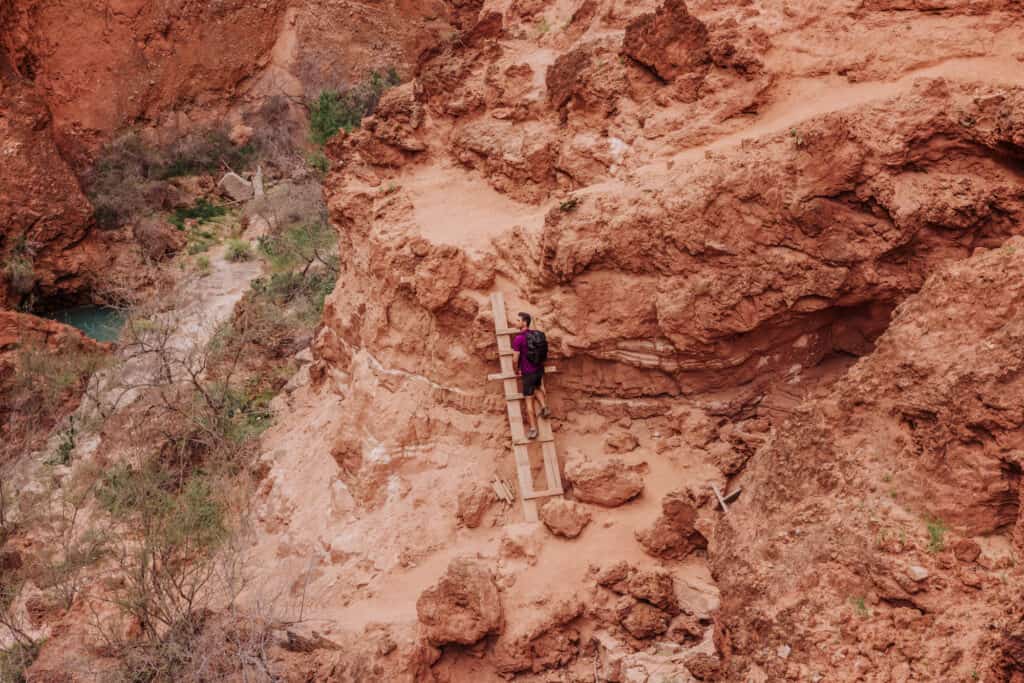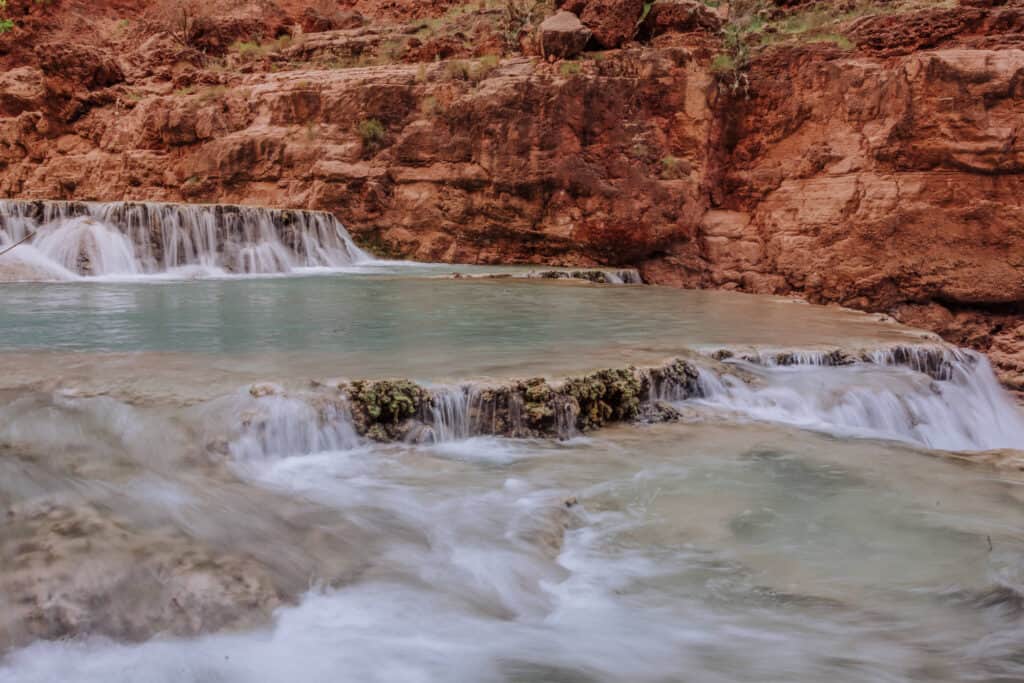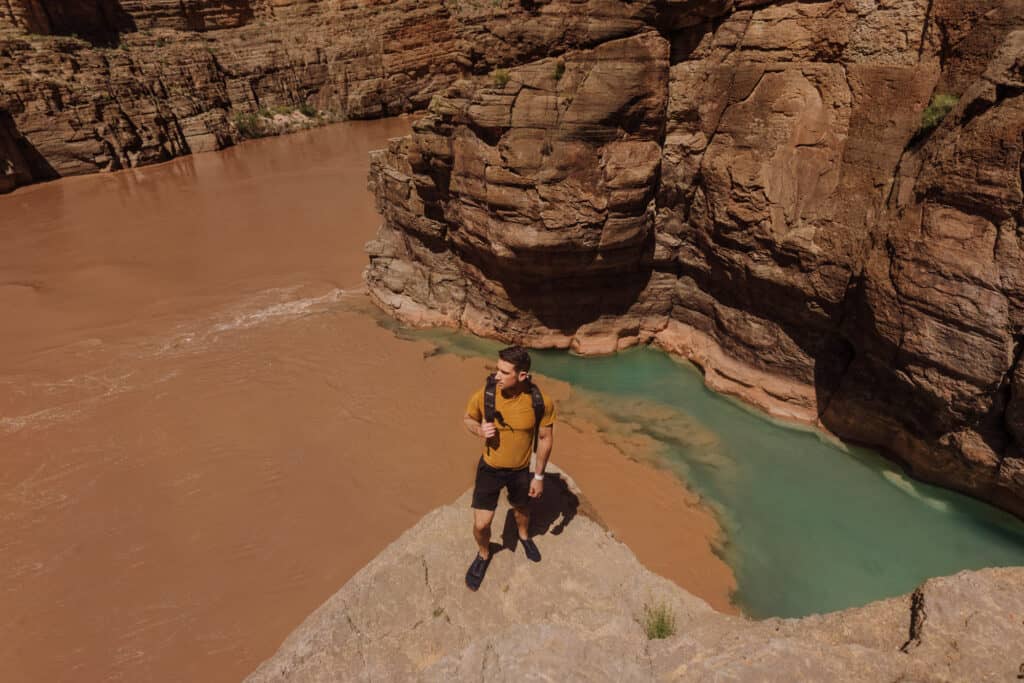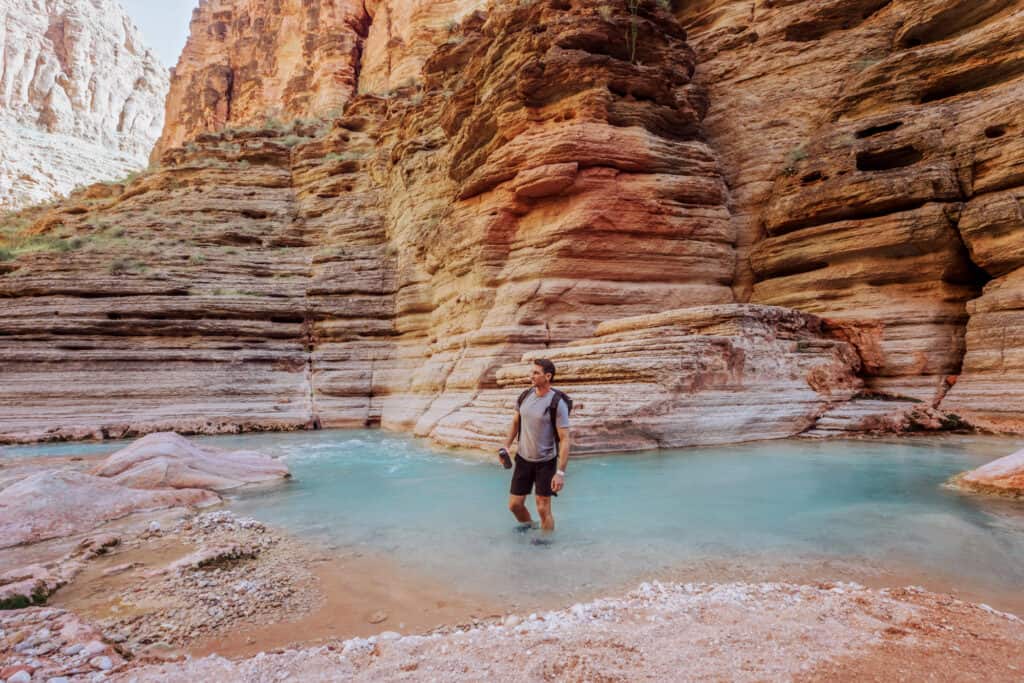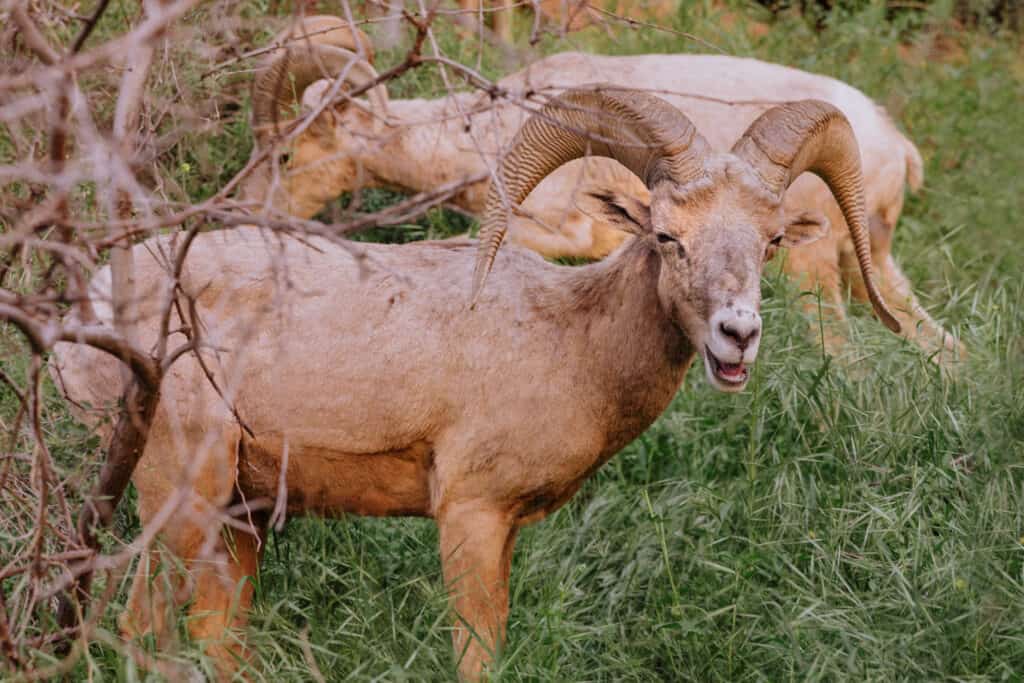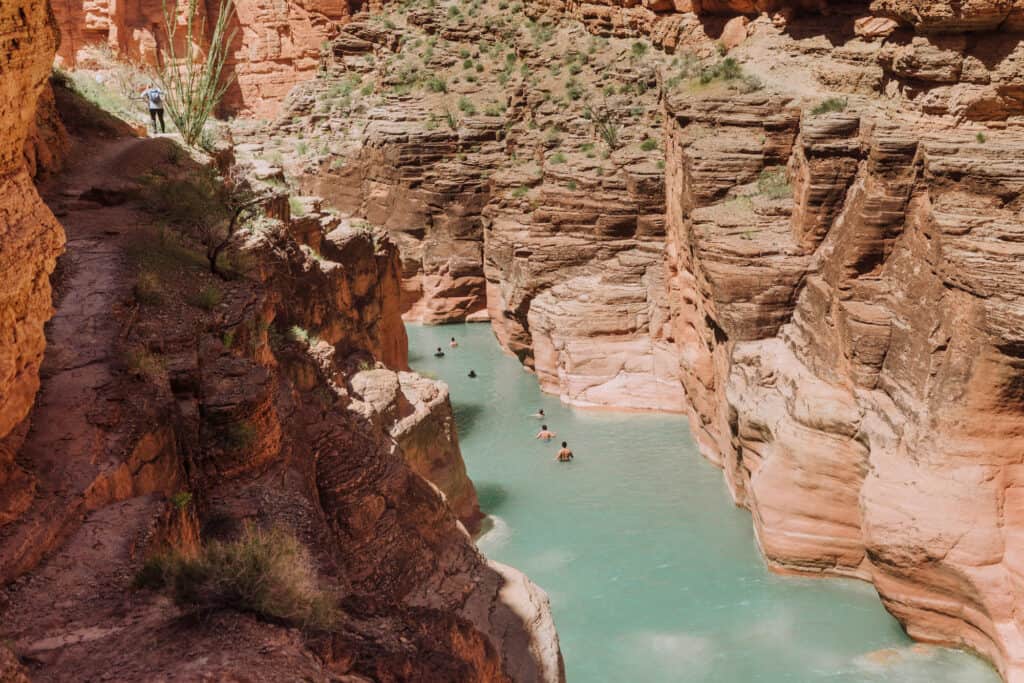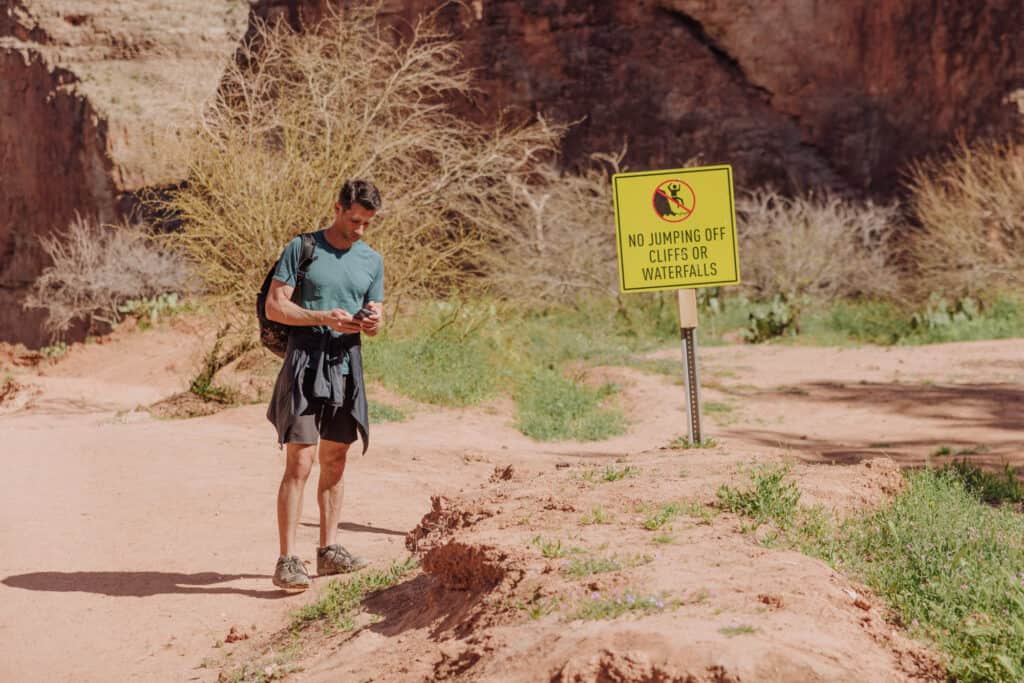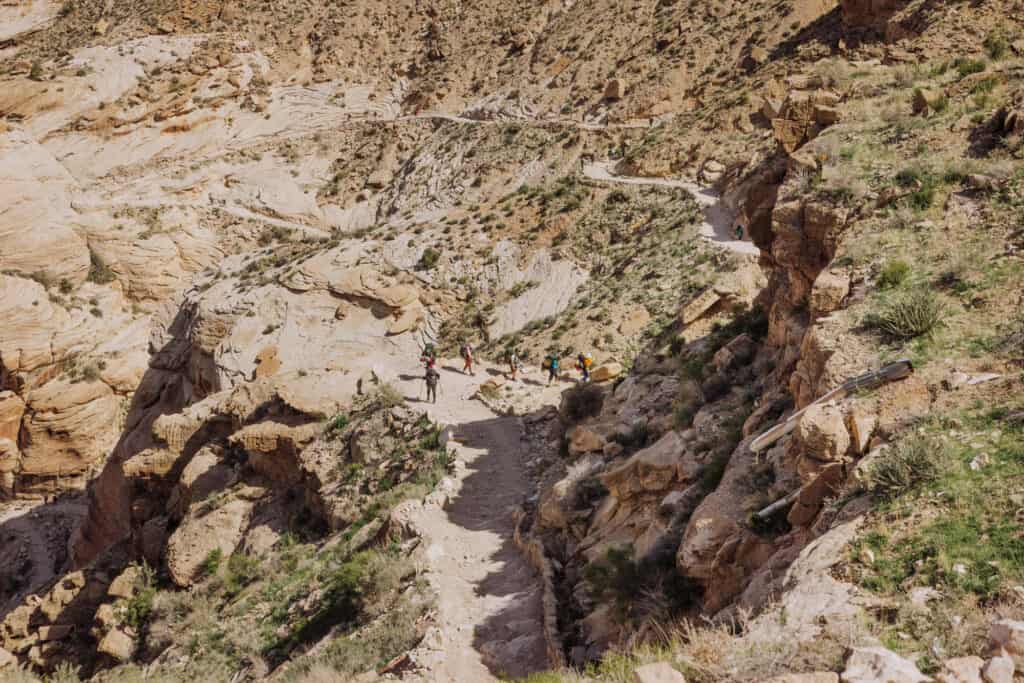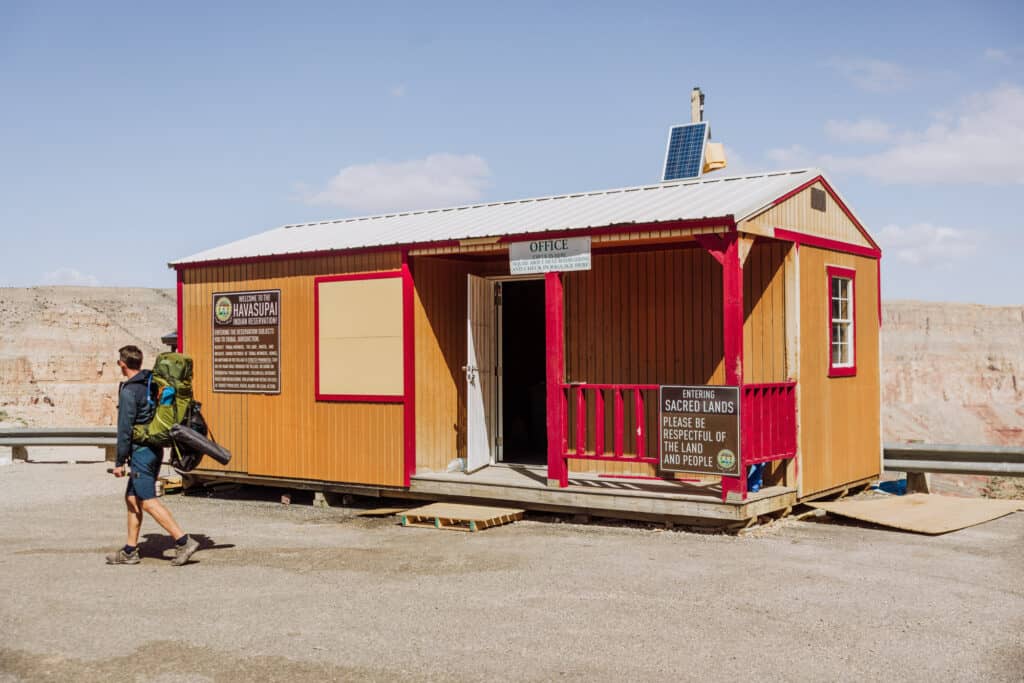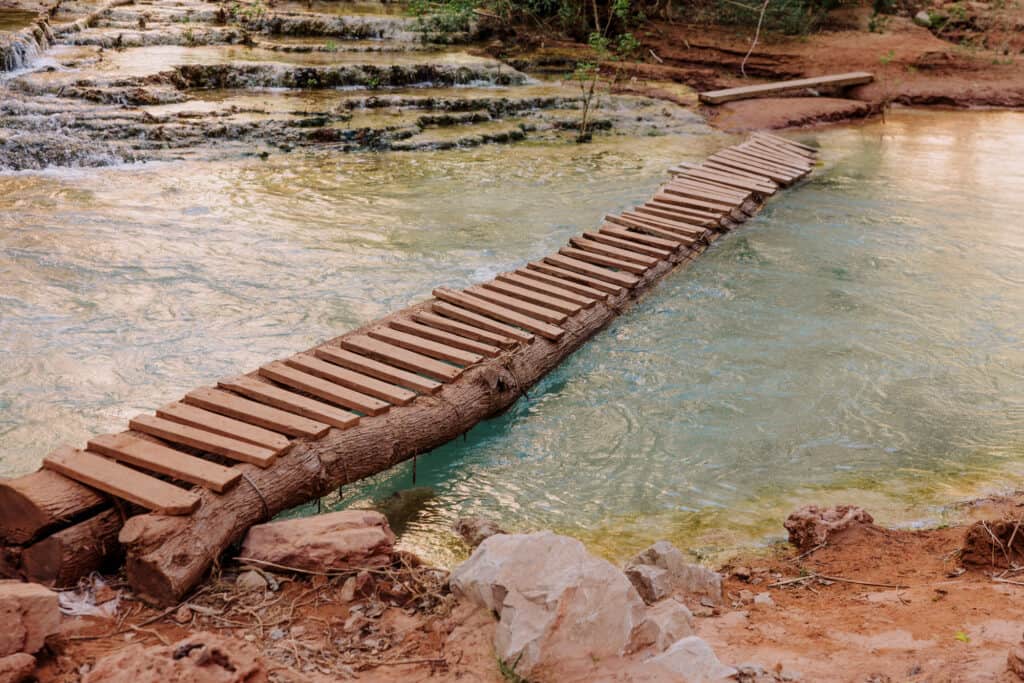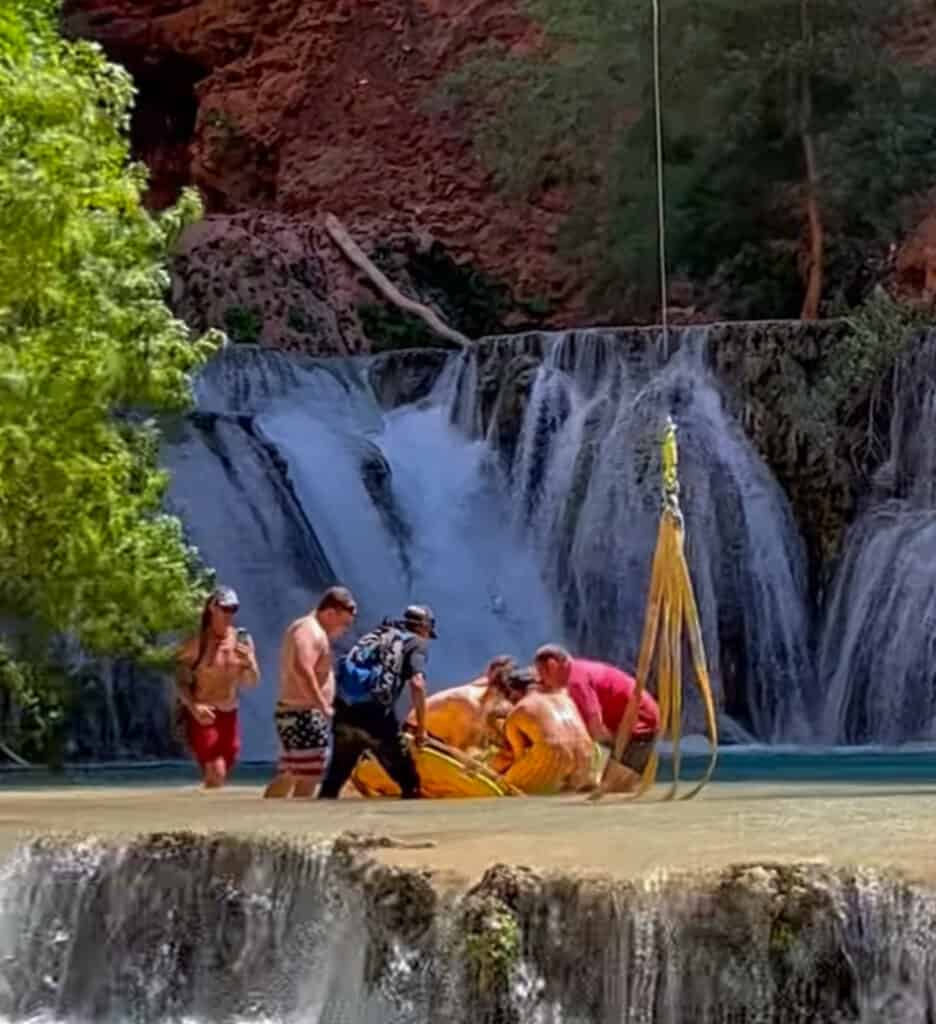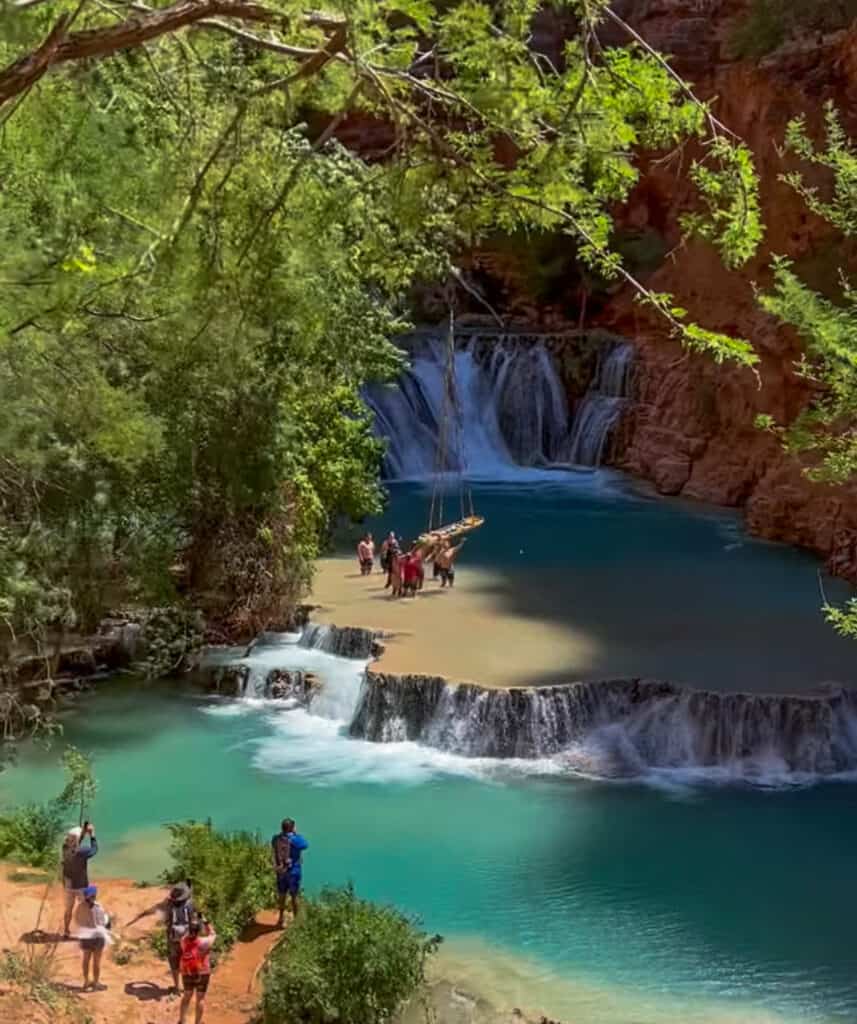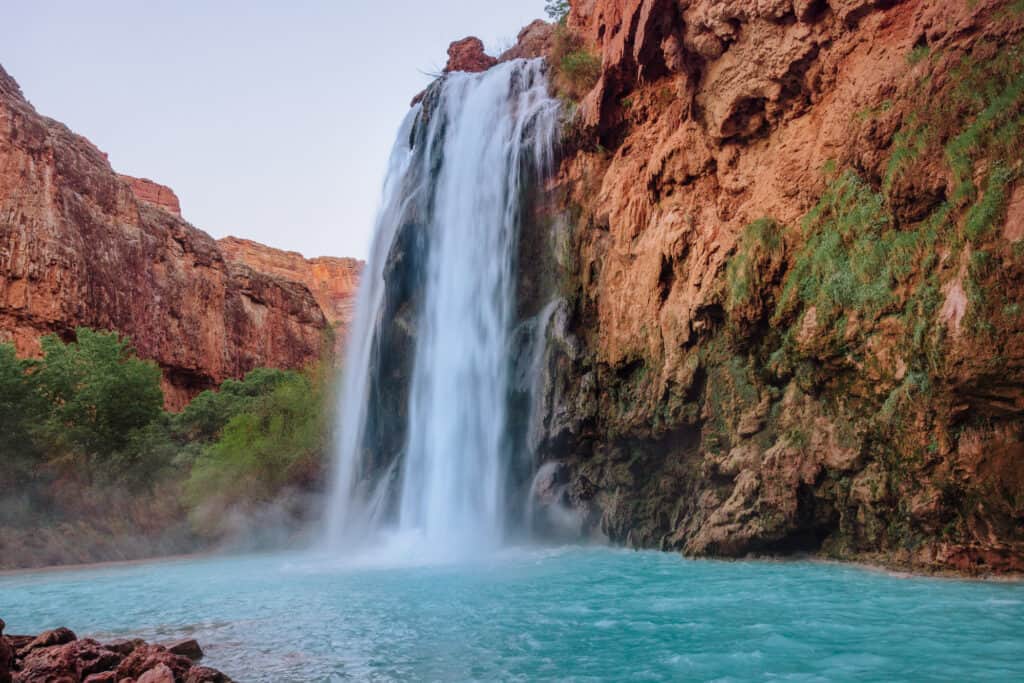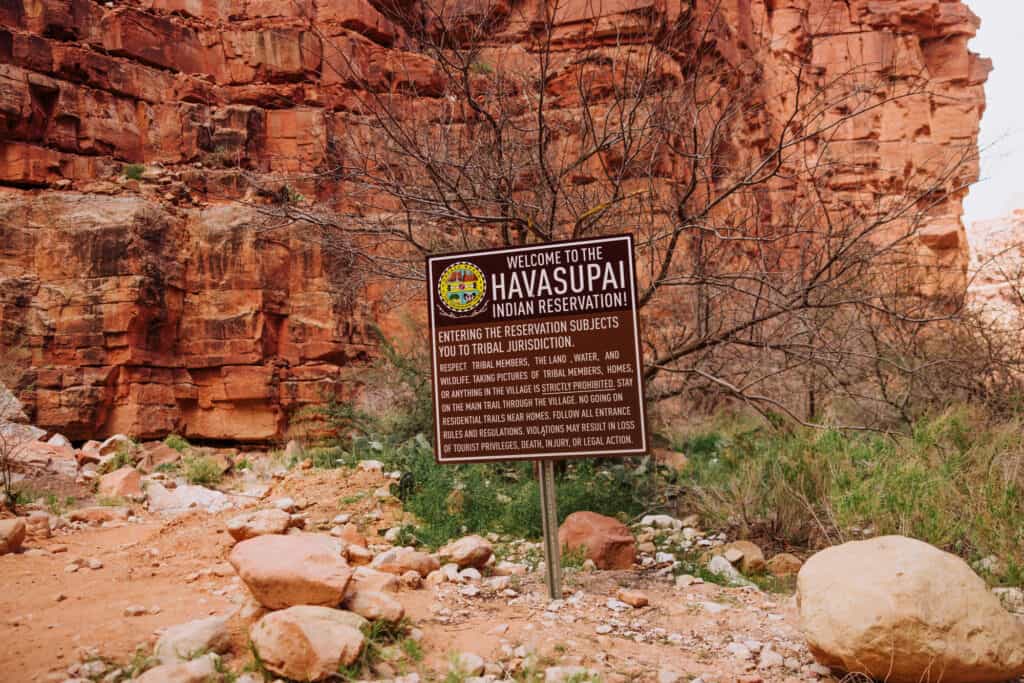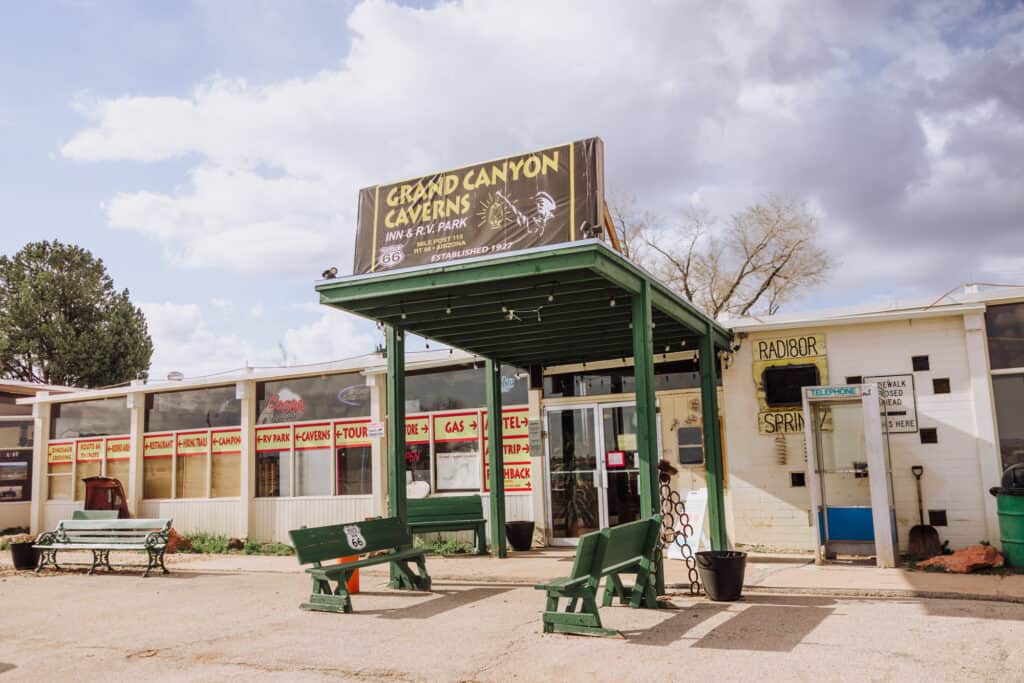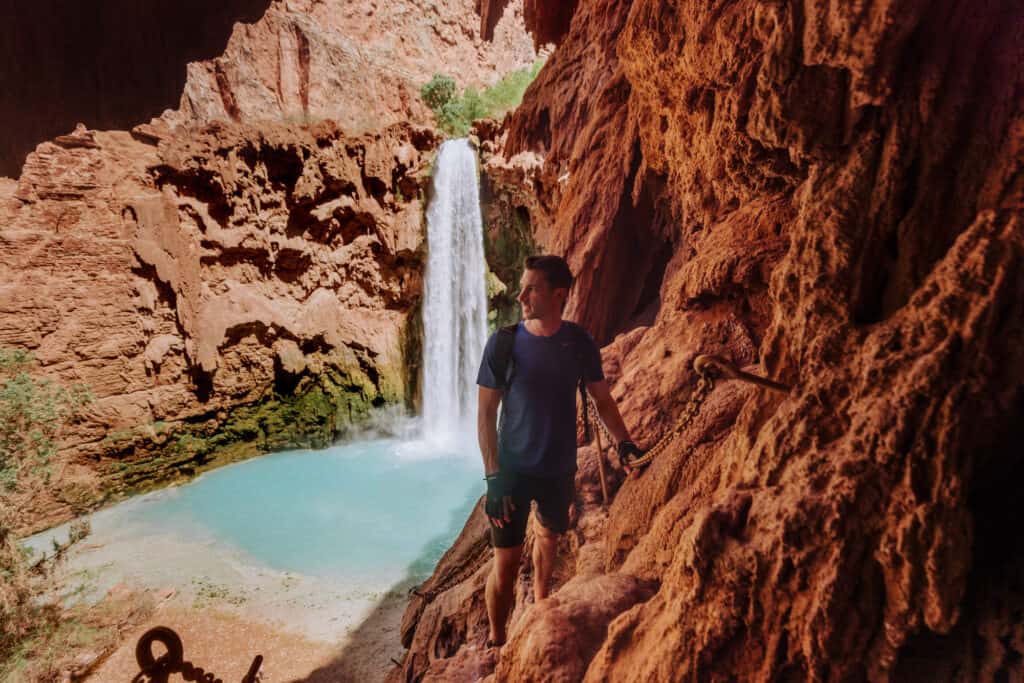The Havasupai Waterfalls: A Map & Guide to Havasu Falls
Havasu Creek, one of the main tributaries to the Colorado River, creates an oasis of lush landscaping through the desert and a series of cascades which make up the Havasupai Waterfalls.
A GUIDE TO THE 6 HAVASUPAI WATERFALLS
While some people call the entire area “Havasu Falls,” Havasu refers the creek that runs through the canyon into the Colorado River. It’s also the name of the waterfall that marks the start of the Havasupai Campground.
Key Info on the Havasupai Waterfalls
- Fifty Foot Falls: Somewhat hidden, stunning, and uncrowded.
- Little Navajo Falls: Easy to get to and a great swimming spot
- Hidden Falls: Smaller but very pretty and uncrowded.
- Havasu Falls: Accessible to all and creates a dramatic entry to the campground.
- Mooney Falls: The tallest, with a notorious vertical ladder to climb down.
- Beaver Falls: Formed by the creek cascading over travertine shelves.
Havasu Creek Runs into Havasu Falls
Havasu Creek is one of the biggest tributaries to the Colorado River. It’s spring-fed from snowmelt and runoff on the Kaibab Plateau.
Over the course of about 20 miles, Havasu Creek cascades over the rocky terrain several times, creating unique waterfalls that are now world-famous.
Why is Havasu Creek’s Water Blue?
“Havasupai” means “people of the blue-green water.”
The Havasupai Tribe says a heavy concentration of lime in the creek creates the turquoise hue that makes this area famous.
The Water Temperature at Havasupai Falls
A lot of blogs say the water temperature in Havasu Creek is a steady 70 degrees Fahrenheit all year. That’s not true.
The USGS tracks temperature readings daily. Not only does the temperature fluctuate through the seasons, the gauges show: it fluctuates by five degrees everyday.
Here’s a sample of a year’s worth of water temperature readings from the USGS gauge in Havasu Creek.
In the summer, the water temperature in Havasu Creek is in the 70-to-75 degree range. I’ve seen the gauge hit near 80 during peak heat!
In the spring and fall, the creek’s temperature is usually in the 60s. It drops down into the 50s during the winter months.
Map of Havasu & the Other Havasupai Waterfalls
This map shows the series of waterfalls along Havasu Creek, and also references (not to scale) the hike in from the Hualapai Hilltop / Havasupai Trailhead. It’s an eight-mile hike from the trailhead to the village of Supai:
From the village of Supai, moving northwest along Havasu Creek, you’ll pass:
- Fifty Foot Falls & Hidden Falls
- Little Navajo Falls
- Havasu Falls
- Mooney Falls
- Beaver Falls
- The Confluence (with the Colorado River in the Grand Canyon)
Where are the Havasupai Waterfalls?
From the satellite view, Havasupai Falls appears very close to the Grand Canyon. It’s part of the same canyon system, carved by the Colorado River and its tributaries, like Havasu Creek.
Mileage to Havasupai Falls
Havasupai Falls is in a remote area. The nearest town is Peach Springs, Arizona, which is an hour south on Indian Road 18, along Route 66.
Here are some other mile markers to the Havasupai Trailhead from major cities:
Las Vegas to Havasupai Trailhead
- 220 miles
- 3.5 hours drive
Phoenix to Havasupai Trailhead
- 260 miles
- 4+ hours drive
Flagstaff to Havasupai Trailhead
- 165 miles
- 2.5 hours drive
Sedona to Havasupai Trailhead
- 190 miles
- 3+ hours drive
Grand Canyon (South Rim) to Havasupai Trailhead
- 190 miles
- 3+ hours drive
Permits for Havasupai Waterfalls
To keep beautiful Havasupai Falls from being overrun by tourists, the Havasupai Tribe puts strict limits on permits.
After a three-year Covid closure, the tribe reopened the area for visitors in 2023.
Permits are required, and there are two ways to get one:
- Wait until February 1st of each year when that year’s reservation system opens.
- Check the cancellation list every morning for upcoming dates this year.
Surrendered permits can be transferred to anyone who wants to buy them. This can only be done on the official Havasupai Tribe Reservation website.
The cost to buy one of the transferred Havasupai Falls permits is $455 (per person) in 2024. If the reservation you happen to find for the dates you want is for two people, you’ll pay $910, even if you’re going solo on the hike.
You cannot buy partial reservation transfers.
Fifty Foot Falls
Fifty Foot Falls can go overlooked by visitors to Havasupai, but for many of those who seek it out, it ends up being a favorite spot.
It’s the first waterfall along Havasu Creek, after passing through the village of Supai on your way to the Havasupai Campground.
The flow of water over Fifty Foot is impressive, but light enough to walk under (in normal conditions). The pool downstream from the falls is a favorite swimming hole along Havasu Creek. Plus, chances are: you might be the only one there!
How to Get to Fifty-Foot Falls
You won’t see Fifty Foot Falls from the hiking trail itself. It’s roughly halfway between the village of Supai and the Havasupai Campground.
Along the trail, you’ll look down and see terraces in the creek. Fifty Foot Falls is in this area, between the village and the campground.
You *will see Little Navajo Falls, and hike in toward the creek there. Head upstream from Navajo Falls along the left side of the creek and you’ll come up to Fifty Foot Falls.
Floods again made some changes to the terrain around Little Navajo and Fifty Foot Falls in 2023. They’ve altered the path many times over the years.
Another benefit of spending time at Fifty Foot Falls: it’s sunnier for more hours of the day (compared to, say, Beaver Falls). The canyon walls around it aren’t high, so they don’t block much of the morning or afternoon sun.
Little Navajo Falls
Little Navajo Falls is probably the greatest modern-day example of the evolution of Havasu Creek.
Residents of Supai remember, as the floodwaters rushed through the village in August of 2008, the creek changed course and started flowing over what is now called Little Navajo Falls.
To visitors these days, it appears Little Navajo Falls has always been there the way it is now. It’s perfectly nestled down below the hiking trail. It’s a wider waterfall, with rocks to climb on and a pool to swim in.
How to Get to Little Navajo Falls
You’ll find Little Navajo Falls between the village of Supai and the Havasupai Campground. It’s about a mile walk up from the campground to the waterfall.
The waterfall can be spotted from the main hiking trail. The floods in 2023 washed over part of the trail to get down there. While the waterfall is still accessible, it’s another example of how Little Navajo Falls (and the trail to get there) will likely change a bit each year.
Havasu Falls
Havasu Falls is probably the most well-known and most visited waterfall along Havasu Creek.
It’s a jaw-dropping welcome to weary hikers. Havasu Falls reveals itself as you walk down the trail into the Havasupai Campground.
The creek water drops around 100 feet over Havasu Falls, pooling into a bright blue pool below.
How to Get to Havasu Falls
Havasu Falls is about a 10-mile hike in from the Hualapai Hilltop and Havasupai Trailhead.
The falls are two-miles downstream from the village of Supai. They serve as the symbolic beginning of the lengthy Havasupai Campground.
What You’ll Find at Havasu Falls
Havasu Falls is a favorite spot for visitors to Havasupai, because it’s accessible to all.
It’s conveniently located just outside the campground, and the path down is relatively easy to navigate.
You’ll find a couple of picnic tables and rocks to sit on, and trees for shade. Many people hang out here for the day, swimming and sunbathing.
Others bring hammocks to hang in the trees, and lounge in the pools downstream from the base of the waterfall.
Off to the side, there’s a small cave with cooler air during the summer. You can great photos of the falls from the other side of the opening!
Havasu Falls was once known as “Bridal Veil Falls.” A century ago, the waterfall was much wider, stretching across the entire rock ledge.
Havasu Falls Floods
All of the Havasupai waterfalls are prone to flooding, usually from snowmelt in the spring and monsoon storms late in the summer.
Havasu Falls really puts the power of Mother Nature on full display, as the beautiful blue waterfall turns into a torrent of mud and debris.
Sometimes the water clears up by the next day. Other times, including after flooding in March of 2023, it takes more than a week to revert back to its trademark blue hue.
Mooney Falls
Mooney Falls is the biggest waterfall along Havasu Creek. It’s more of a challenge to get to, since it requires a steep climb down a vertical rock wall.
It’s about a 200-foot climb down the rocks to the base of Mooney Falls. It was named after a miner (with the last name of ‘Mooney’) who fell to his death in the late 1800s, while trying to scale the rocks. He was carrying an injured miner on his back during the climb up.
Where is Mooney Falls
While Havasu Falls marks the beginning of the Havasupai Campground, Mooney Falls marks the end.
Havasu Creek runs for about a mile between the two waterfalls, and you’ll find tents and campers dotting the blue-water creek the entire way.
How to Get to Mooney Falls
The hike down to the base of Mooney Falls is infamously difficult. For some, it’s a highlight of their entire trip to Havasupai. Others take a look at the rock cliff, and simply opt-out.
You’ll pass through two tunnels, which are short enough that they don’t require any extra lighting. Miners in the 1880s blasted holes through the rock to create the tunnels, to make the trip down more accessible.
After the tunnels, you reach the vertical drop. You’ll rely on chains attached to the rocks with spikes, along with jagged steps in the rock wall to get down.
The last 20-feet or so will be on a wooden ladder to the base of the falls.
The mist that will soak you on the descent will either be cooling and welcomed during the summer … or freezing and hellish during the spring and fall!
Gloves are a huge help for the climb down! There’s usually a pile left by past hikers for you to grab if you didn’t bring your own. Plus, thankfully despite the mist, there’s no moss or anything slippery growing on the rocks or ladder to create even more of a hazard.
Depending on the crowd, you could end up waiting a long time to climb up or down. The pathway is single-file. Sometimes if there’s a backup, you could wait an hour or longer at the base for a clearing to start your climb back up.
Can You Swim at Mooney Falls?
The entire trip to Mooney Falls is “at your own risk.” The blue water is definitely inviting, and there’s plenty of room to wade around in it.
Beware of the dropoff into the deeper part of the pool, and the undertow by the falls themselves.
The current there has been deadly in the past.
There’s no rock jumping or cliff diving allowed.
Beaver Falls
Beaver Falls is a visually stunning series of cascading waterfalls, created by travertine. The minerals in the water of Havasu Creek trap twigs and rocks, building the series of shelves and pools you see there today.
How to Get to Beaver Falls
The hitch to getting to Beaver Falls is: you have to scale the rock wall at Mooney Falls first.
From the base of Mooney Falls, the hike to Beaver Falls is about three-miles.
It involves several creek crossings, the first of which comes about a third of a mile into your hike beyond Mooney.
Several times along the hike you’ll find opportunities to enjoy the scenery and swim in other parts of Havasu Creek. You’ll find a few picnic tables along the trail, which is easy to navigate and follow.
Your first view of Beaver Falls will be from a cliff above them. From here, it’s a climb down another steep, rocky path to the creek. There are a few ladders to help you along the way. It’s much easier than the climb down the rocks at Mooney Falls!
Can You Swim at Beaver Falls?
Beaver Falls is a favorite swimming spot along Havasu Creek! The pools of water aren’t too deep, and there’s plenty of space for people to spread out on the banks of Havasu Creek.
As noted above, jumping from the cliffs and rocks above the pools has proven to be dangerous and even deadly.
Because of how it’s situated between the tall canyon walls, the sun doesn’t shine late into the afternoon. You’re likely to see the place clear out as the sun starts to dip behind the canyon walls later in the day.
The Confluence
Havasu Creek is the second largest tributary to the Colorado River. You can follow the blue waters in the creek all the way through a canyon to a place called “The Confluence,” where it flows into the Colorado.
It’s a really nice hike, and interesting to see the blue water of the creek mix with the muddy water of the Colorado.
How to Get to the Confluence
The hike to the confluence is a FULL day-trip. It’s roughly an 18-mile round trip from the Havasupai Campground.
Yes, first you have to scale the rock wall at Mooney Falls, and hike past Beaver Falls to head toward the confluence. You’ll see a sign above Beaver Falls, warning you not to leave that spot for the confluence after 10:30am. We left right at 10:30, and were back by 5:30.
The hike to the confluence isn’t overly challenging. There’s not much elevation change at all.
Definitely bring a LifeStraw, or similar filtration bottle. It’s perfect for a creekside hike!
Choose your footwear wisely, since you’ll have to cross Havasu Creek at least seven times along the way. The creek is knee-deep in spots, and waist-deep in others, depending on the flow (and your height!).
As an added surprise on the hike back later in the day, you’re likely to see desert big-horned sheep along the trail! They come down from the rocky cliffs in the evening as the sun sets behind the canyon walls to graze on shrubs and grass.
Can You Swim at the Confluence?
You can swim in the canyon leading to the confluence, but take note of the current. It starts moving rapidly toward the end, and you don’t want to be swept out into the Colorado River.
We were lucky to have a tied-up river raft to climb up at the end, and we helped two other men who were stuck in the water up to safety.
In much of the year, the water is lower and there’s no danger.
Cell Signal at Havasupai Falls
A lot of people love going to Havasupai to unplug and disconnect, but in case you want to send an “I’m alive” text back home, Little Navajo Falls is the place to give it a try.
From the trail above the falls, you’re likely to get a cell signal. You can also try near the top of Havasu Falls. I got just enough of a signal to send a text home to say I survived the hike!
Hike to the Havasupai Waterfalls
Whether you hike in to the Havasupai Waterfalls or take a helicopter, the adventure always begins on a remote, rocky hilltop an hour north of Peach Springs, Arizona. It’s the only town for many miles around.
Most people choose to hike the 10+ miles from the trailhead at the hilltop parking lot to the Havasupai Falls Campground.
It’s a strenuous but beautiful hike, beginning with a series of switchbacks that take you down into the canyon.
From there, you’ll continue several miles through a dry wash until you reach Havasu Creek. Following the blue waters, you’ll pass through the village of Supai and then into the campground.
Visitors in the summer often leave on the hike before dawn, to avoid the intense daytime heat.
There’s no water along the way, until you reach the creek, so bring plenty with you. Fill up *before you drive to the trailhead, because there are no services at all there. It’s really just a small ranger office, and a composting outhouse in the parking lot.
Camping at the Havasupai Waterfalls
The rushing water of Havasu Creek will lull you to sleep at night after your hikes.
You have a stretch of more than half-a-mile to choose from along the creek to setup your tent.
- Pick a spot with a picnic table
- Don’t camp near the bathrooms
- The composting outhouses run out of toilet paper by midday
- Bring a water filtration bladder to fill up from Fern Spring or the creek itself
- No drones, fires, or alcohol allowed
The Best Month to Visit Havasupai Waterfalls
The best month to visit the Havasupai Waterfalls is up for debate.
Personally, for me, it’s too cold from mid-October through mid-April in this area!
I’d aim for April 15 through June. While the desert gets really hot in June, you’ll still find shade along the hike AND be able to cool off in the creek at the campsite.
By July, you run the risk of monsoon rainfall impacting your visit. Monsoon season runs through September, so it’s definitely something to keep in mind when you plan your travels to the Havasupai Waterfalls.
Havasupai Falls Rescues and Deaths
In September of 2024, a flash flood swept a woman to her death as she was near the confluence. The flood wiped out the campground, and the governor sent the Arizona National Guard to rescue 100+ hikers and campers.
In July of 2023, as Arizona suffered from an intense heatwave, temperatures at Supai soared above 100 degrees.
The blue waters of Havasu Creek were more enticing than ever to cool off in, but sadly several hikers were severely injured in July, and one man even lost his life.
Most of the injuries at Havasupai Falls are happening at Beaver Falls. It may be surprising, since Beaver Falls is so serene compared to the more dramatic and seemingly-dangerous Mooney Falls or Havasu Falls.
The injuries are largely the result of people climbing the rocks and cliffs around Beaver Falls. Some slipped and fell, while others purposely jumped into the pool below and landed on rocks that are hidden underwater.
While some injuries at Havasupai Falls in 2023 were minor, like cuts and sprains, several required an emergency helicopter rescue.
In one case, a young man who was cliff-jumping into a pool at Beaver Falls hit his leg on a rock in the water. Witnesses say it shattered his knee, and tore tendons. They helped comfort him as best as possible on the trail, while they waited for a helicopter to come hoist him out of the canyon.
Another woman was using a rope to climb the rock wall on the other side of Havasu Creek, above Beaver Falls. She slipped, fell, hit her head, and landed unconscious in the water. Other hikers rescued her, and she regained consciousness as they waited for several hours for the helicopter to fly her out. She was taken to a hospital in Flagstaff, and friends later said she thankfully didn’t suffer any serious injuries.
Helicopter rescues at Havasupai Falls are challenging and dangerous, and the injured hiker is responsible for the bill.
The injuries and death at Havasupai Falls are very sad reminders of the dangers you face on a visit. The Havasupai Tribe says cliff-jumping is prohibited for this reason.
FAQs About the Havasupai Waterfalls
Let’s tackle a few remaining frequently-asked-questions about visiting the Havasupai Waterfalls.
When did Havasu Falls Reopen?
Havasu Falls and the rest of the Havasupai Waterfalls reopened in February of 2023, after a three-year pandemic closure.
Are Havasu Falls and Havasupai Falls the same?
Havasu Falls is one of several waterfalls along Havasu Creek. It flows through the Havasupai Reservation, so collectively all of the waterfalls are Havasupai Falls.
Is Havasupai Falls in the Grand Canyon?
On the satellite view, you’ll see Havasupai Falls is on the western side of the canyon system which includes the Grand Canyon.
The border of the Havasupai Reservation and the Grand Canyon National Park is along the hiking trail between Beaver Falls and the confluence.
Are the Havasupai Waterfalls open to visitors year-round?
The Havasupai Tribe closes to visitors in December and January.
What hotels are near the Havasupai Waterfalls?
There are very few hotel options nearby. While you’ll have to check-in before your hike at the Grand Canyon Caverns Inn, I’d suggest the Hualapai Lodge. It’s a 10-minute drive from the Caverns, and is a bit nicer. Their restaurant serves a great breakfast, too!
You can use this interactive map to see the options for your dates:
Wrap: Is Havasupai Falls Worth the Hype
For me, it was worth my 10-year wait to visit Havasupai Falls!
The scenery surpassed my expectations. The hiking and rock climbing was more intense than I expected, and the water was more blue than I expected.
The waterfalls in Hawaii, Iceland, Costa Rica are all gorgeous, but Havasupai Falls is truly a unique, pristine spot. You’ll find yourself constantly wondering, “How on earth is this oasis in the middle of the desert southwest!?”
